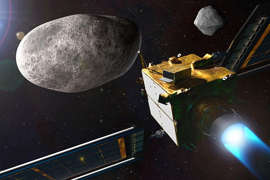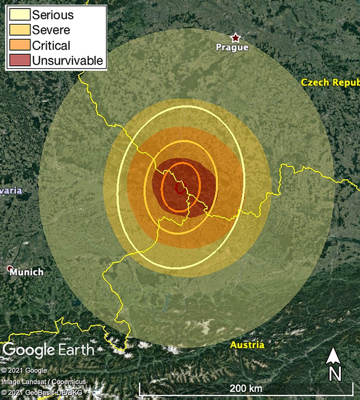
65 million years ago, the fall of the 10-kilometer asteroid Chicxulub to Earth caused a catastrophe on a planetary scale and led to a mass extinction, in particular, to the death of dinosaurs. A repetition of this scenario cannot be ruled out. What the Chelyabinsk meteorite recalled not so long ago. Can humanity prevent such a catastrophe? Scientists were looking for an answer to this question during the 7th conference on planetary protection of the International Academy of Aeronautics. As part of this event, with the participation of specialists from NASA and the European Space Agency, exercises were conducted to repel the asteroid threat.
Under the terms of the simulation, scientists noticed the dangerous asteroid when it was 57 million kilometers away. According to the initial calculations of the trajectory of its movement, the chances that it will collide with the Earth were 5 percent. The fictional asteroid was named 2021PDC and had a flight time of 6 months. Then it was necessary to accurately calculate its size, orbit, to clarify the probability of collision with the Earth and the exact place of fall. And, naturally, find a way to eliminate the threat.
Experts believe that at the moment, an effective means of preventing a collision is to hit an asteroid with a space rocket. By the way, it is this method of influencing the killer asteroids that will be practiced as part of the DART training mission. The launch of the space probe-impactor is scheduled for November 2021, its target is the double asteroid Didim. It is a system of two celestial bodies, the diameter of the main asteroid is 780 meters, and a 160-meter satellite rotates at a distance of 1 kilometer from it. The spacecraft will reach Didyma in October 2022 and strike a small satellite – it is he who fits in the size of the class of asteroids that pose the greatest threat to Earth. Larger objects have already appeared on radar screens. The mass of the spacecraft is small – only 500 kilograms, but the collision will occur at a speed of 6.6 kilometers per second and, according to scientists' calculations, the kinetic energy of the impact is enough to move the asteroid out of orbit.

Two years ago, during previous exercises to save the planet, scientists did just that. They launched a virtual strike on the asteroid, directing a spacecraft at it, but the simulation of the situation gave an unexpected result. An 80-meter fragment of an exploded asteroid “landed” right in the Central Park of New York. Fortunately, scientists calculated the crash site 10 days before the disaster and, if the situation were real, the authorities had time to evacuate the residents of the metropolis.
However, during the current exercise, the planet defense experts have been put on a tighter time frame – just 6 months from the moment the threat was detected to the impact. As a result, experts came to the conclusion that today at the disposal of mankind there are no technologies with the help of which, in conditions of such time pressure, it would be possible to destroy a dangerous asteroid or change its trajectory.
“We were considering options to detonate or destroy an asteroid with a nuclear explosive device,” NASA experts said in a press release. – However, if 2021PDC existed in real life, we would not have had time to prepare and launch the spacecraft in such a short time.
DART team member planetary geologist Angela Stickle, who also participated in the exercise, explained that impact spaceships work well when there are several years in reserve. The impact that the spacecraft can deliver is not very strong and it takes time for the trajectory of the asteroid to change.
– Even if we had time to launch a spaceship with a kinetic percussion mechanism like DART, we would not have time to knock the asteroid off course, – says Angela Stickle.
Simulations have confirmed that the problem can only be solved by creating an early warning system for the asteroid threat. Two years ago, NASA announced the upcoming launch of a new space-based infrared telescope that will purposefully track dangerous asteroids over 140 meters across. The telescope, dubbed the Near-Earth Observing Mission, is due to launch in 2025. Together with the telescopes of the European Space Agency (NEOSTEL project), it will form a unified early warning system. Which will be very handy, because according to scientists' estimates, today about two-thirds of asteroids 140 meters in size or more remain undiscovered. They are large enough to wreak havoc on the planet.
Simulations have shown that with the current level of development of space technology, scientists took two months of observations to determine the exact place of the impact of the killer asteroid. It turned out to be the space between Munich and Prague, on the border of the Czech Republic, Germany and Austria. And the exact size of the asteroid was calculated only six days before the disaster, when the celestial visitor entered the zone of the Goldstone Solar System Radar – a large radar system located in California. The “training” asteroid 2021PDC turned out to be smaller than expected – only 105 meters in diameter. But even this is quite enough to cause serious damage to all living things within a radius of 160 kilometers from the crash site. The effect will be the same as from the explosion of a large nuclear bomb. According to calculations, Prague could also fall into the destruction zone. In conditions when it is impossible to knock the asteroid out of the way, there is only one way out – the evacuation of the population.
This is the seventh attempt by planetary threat experts to simulate the consequences of a real asteroid attack. At the current level of our technical capabilities, the conclusions are disappointing – if an uninvited and formidable guest really looms on the horizon, we are all screwed.

